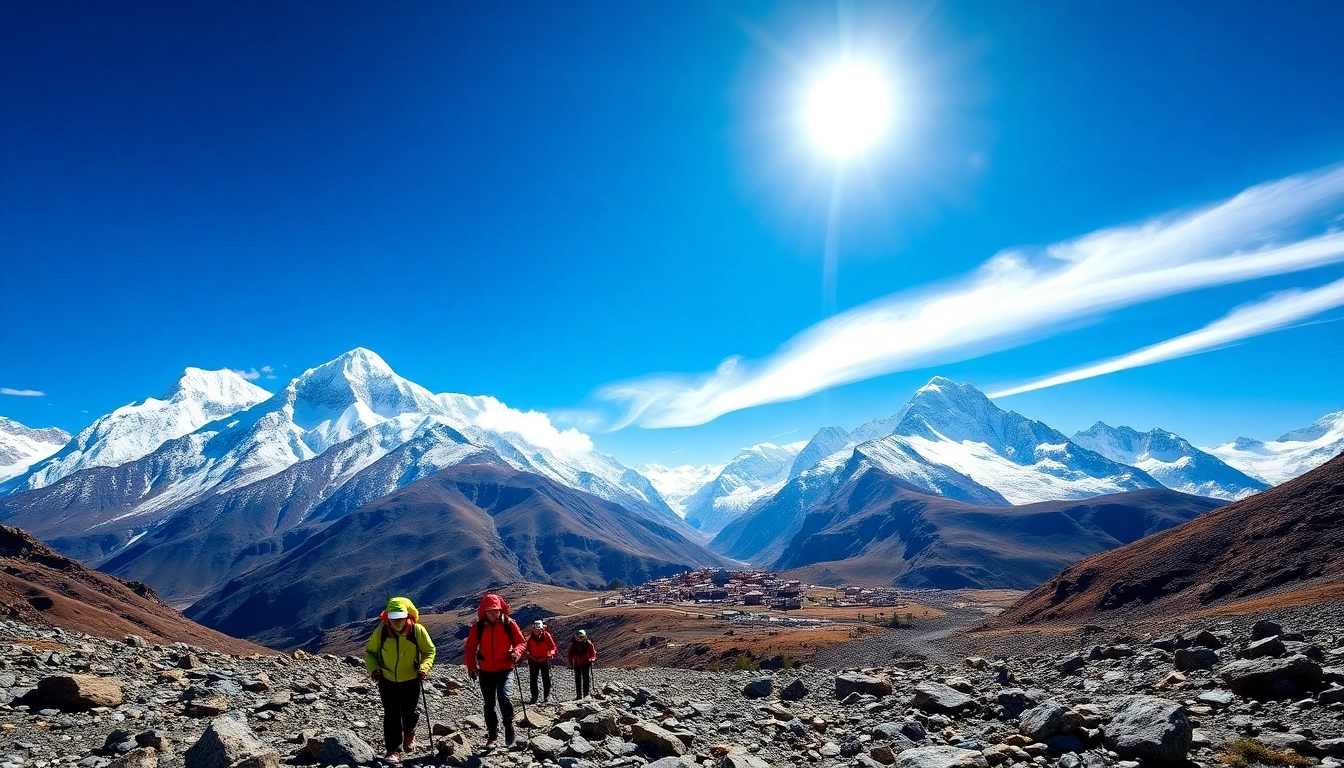Overview of the Everest Base Camp Trek
What is the Everest Base Camp Trek?
The Everest Base Camp Trek is one of the most iconic and sought-after trekking routes in the world, leading adventurers through the breath-taking landscapes of the Khumbu region of Nepal. This trek traditionally begins in Lukla, an aerodrome town accessible by a dramatic flight from Kathmandu. The trek culminates at Everest Base Camp, situated at an altitude of 5,364 meters (17,598 feet), on the southern slopes of Mount Everest. Trekkers are rewarded with stunning views not only of Everest but also of other majestic peaks such as Lhotse, Nuptse, and Ama Dablam, creating a panorama that is truly unforgettable.
History and Significance of the Trek
The history of the Everest Base Camp Trek is intrinsically tied to the climbing history of Mount Everest. The first foreigners to reach Base Camp were members of a British expedition led by George Mallory in the early 20th century. Since then, the trek has evolved from a climbers’ route into a popular trekking trail frequented by travelers from all over the globe.
This trek not only serves as a physical challenge but also connects trekkers with the rich heritage and culture of the Sherpa people, who have called the Khumbu region home for generations. The Sherpas’ profound connection to the mountain, along with their hospitality, adds tremendous value to this journey, making it more than just a hike; it is an immersive experience into a unique culture.
Who Should Consider the Everest Base Camp Trek?
The Everest Base Camp Trek is suitable for a broad range of trekkers. Those with moderate fitness levels who enjoy hiking can undertake it, as the trail is well-trodden and supported by local tea houses that provide food and lodging. However, the high altitude presents challenges, requiring adequate preparation and acclimatization.
Adventurers seeking a life-changing experience, spectacular natural beauty, and a glimpse into the Sherpa way of life will find this trek immensely rewarding. Whether you’re a seasoned trekker or a beginner, the journey to Base Camp offers a sense of accomplishment and connection to one of the world’s most revered mountain environments.
Planning Your Everest Base Camp Trek
Best Times to Trek Everest Base Camp
The best time to embark on the Everest Base Camp Trek is during the spring (March to May) and autumn (late September to October). These seasons boast favorable weather conditions, with relatively stable temperatures and clear skies, presenting perfect opportunities for breathtaking views of the Himalayan peaks.
During spring, trekking through blooming rhododendron forests adds a splash of color to the landscape, while autumn provides stunning vistas of the mountains capped with snow. Trekkers should avoid the monsoon months (June to early September) due to heavy rainfall, which can lead to landslides and treacherous paths.
Permits and Regulations for Everest Base Camp Trek
To trek to Everest Base Camp, you must secure several permits to comply with Nepal’s regulations:
- TREKKER’S INFORMATION MANAGEMENT SYSTEM (TIMS) Card: This card is mandatory for trekkers entering the Annapurna and Everest regions. It serves to track the number of trekkers and ensure safety within the trekking areas.
- Solukhumbu National Park Permit: This permit grants access to the national park encompassing Everest Base Camp. It comes with a nominal fee and supports park conservation activities.
Both permits can usually be obtained in Kathmandu or through reputable trekking agencies. Ensure you have all documentation ready to avoid any inconveniences during your trek.
Essential Gear for the Everest Base Camp Trek
Equipping yourself with the right gear is crucial for a successful and safe trek. Essential items include:
- Footwear: Invest in sturdy, comfortable trekking boots that provide excellent ankle support and traction.
- Clothing: Layering is key. Pack moisture-wicking base layers, an insulating mid-layer, and a waterproof outer layer. Don’t forget warm hats, gloves, and thermal socks.
- Backpack: A high-quality backpack with sufficient capacity (40 to 60 liters) is essential for carrying your gear comfortably.
- Sleeping Bag: A down or synthetic sleeping bag rated for -20°C to -30°C will keep you warm at elevation.
- Hydration System: A hydration bladder or reusable water bottles help ensure you stay hydrated throughout the trek.
In addition to the essentials, pack items such as a first-aid kit, sun protection, a headlamp, and camera gear to capture the stunning vistas.
Itinerary and Route Details for Everest Base Camp Trek
Day-by-Day Breakdown of the Everest Base Camp Trek Itinerary
The classic itinerary for the Everest Base Camp Trek usually spans 12 to 14 days, allowing optimal time for acclimatization. A sample itinerary may include:
- Day 1: Fly from Kathmandu to Lukla; trek to Phakding (2,610 m).
- Day 2: Trek from Phakding to Namche Bazaar (3,440 m).
- Day 3: Acclimatization day in Namche; explore local sights.
- Day 4: Trek from Namche to Tengboche (3,867 m).
- Day 5: Trek from Tengboche to Dingboche (4,410 m).
- Day 6: Acclimatization day in Dingboche; hike to Nagarjun Hill.
- Day 7: Trek from Dingboche to Lobuche (4,940 m).
- Day 8: Trek from Lobuche to Everest Base Camp (5,364 m); return to Gorak Shep.
- Day 9: Hike to Kala Patthar (5,545 m) for sunrise views; descend to Pheriche.
- Day 10: Trek from Pheriche to Namche.
- Day 11: Trek from Namche to Lukla.
- Day 12: Fly back to Kathmandu.
This itinerary allows trekkers to adjust to altitude carefully while taking in the captivating scenery and rich cultural heritage along the way.
Alternative Routes to Everest Base Camp
While the classic route to Everest Base Camp is immensely popular, several alternative paths offer different perspectives and experiences:
- Three Passes Trek: This challenging route includes the Renjo La, Cho La, and Kongma La passes, providing stunning views of the Everest region beyond the typical trek.
- Gokyo Lakes Trek: Extending beyond Base Camp, this trek takes you to the beautiful Gokyo Lakes, nestled beneath towering peaks, before connecting back to the standard route.
- Jiri to Everest Base Camp: Established trails connect Jiri to Lukla, offering an immersive cultural experience through historical villages.
Choosing an alternative route provides additional opportunities to see the region’s stunning diversity and natural beauty.
Acclimatization Strategies While Trekking Everest Base Camp
Acclimatization is vital on high-altitude treks like the Everest Base Camp Trek. Here are essential strategies to ensure you adapt effectively:
- Gradual Ascent: Avoid ascending more than 300 meters (1,000 feet) per day above 3,000 meters (9,800 feet).
- Hydration: Drink plenty of water; staying hydrated aids acclimatization.
- Nutrition: Consume high-carbohydrate foods to provide energy.
- Rest Days: Incorporate acclimatization days, allowing your body to adjust.
Listening to your body during the trek is crucial. If symptoms of altitude sickness arise, such as headache, nausea, or dizziness, descend immediately and seek medical advice if symptoms persist.
Experiencing Local Culture on the Everest Base Camp Trek
Meeting the Sherpa People
The Sherpa people are renowned for their remarkable resilience and hospitality. Meeting them during the trek provides a fascinating glimpse into their daily lives, culture, and traditions. Sherpas are not only exceptional mountaineers but also skilled artisans, often showcasing their incredible craftsmanship in various forms of art and clothing.
Trekking through their villages, such as Namche Bazaar, allows trekkers to observe traditional architecture, taste local dishes like ‘dal bhat,’ and learn about community practices. Conversations with the Sherpa people can deepen your understanding of the challenges and joys they experience in their unique environment.
Immersive Cultural Experiences Along the Trek
The Everest Base Camp Trek is teeming with rich cultural experiences. Along the route, you will come across ancient monasteries, prayer flags fluttering in the wind, and sacred stupas marking the spiritual significance of the area. Notable stops include:
- Tengboche Monastery: This revered monastery is one of the most significant landmarks in the Khumbu region, renowned for its stunning views and deep cultural roots.
- Namche Bazaar: The unofficial capital of the Khumbu region, this bustling market is where trekkers can purchase local crafts and interact with Sherpas.
- Local Festivals: Trekking during festivals such as Dashain or Tihar offers an opportunity to witness the vibrant traditions and celebrations of the Sherpa people.
These cultural experiences enhance the overall trekking journey, making it a rich, multi-faceted adventure.
Festivals and Events Within the Everest Region
Being aware of local festivals can enhance your trekking experience. Major festivals celebrated by the Sherpa people include:
- Dashain: This 15-day Hindu festival celebrates the triumph of good over evil and is marked by family gatherings, animal sacrifices, and traditional rituals.
- Tihar: Known as the festival of lights, Tihar honors the bond between siblings and includes several days of celebrations filled with music and dancing.
- Lhosar: The Tibetan New Year brings together communities for festivities featuring traditional food, music, and dance.
Experiencing these cultural events during your trek adds a unique dimension, fostering connections with the people of the region.
Tips for a Successful Everest Base Camp Trek
Physical Preparation for the Everest Base Camp Trek
Preparing your body for the rigorous demands of the Everest Base Camp Trek is essential. Start an exercise regimen that includes:
- Endurance Training: Incorporate long hikes and cardiovascular workouts to build stamina.
- Strength Training: Focus on leg and core strength to enhance stability and balance on uneven terrain.
- Hike with a Pack: Practice hiking with a loaded backpack to simulate the conditions you will face on the trek.
Consulting a fitness professional or joining a hiking group can provide valuable guidance and motivation as you prepare.
Nutrition and Hydration During the Trek
Maintaining proper nutrition and hydration is critical for a successful trek. As you ascend to higher altitudes, your body’s caloric needs increase significantly. Consider the following:
- High-Carb Snacks: Pack energy-dense snacks like nuts, dried fruits, and energy bars to keep your energy levels up.
- Meal Planning: Prioritize meals rich in carbohydrates and lean proteins to sustain your strength throughout the trek.
- Hydration: Aim to drink at least 3 to 4 liters of water each day, using purification tablets or filters as needed.
By monitoring your diet and hydration throughout the trek, you can maximize your performance and enjoyment.
Staying Safe and Healthy on the Everest Base Camp Trek
Safety is paramount on the Everest Base Camp Trek. Here are essential tips:
- Acclimatization: As discussed, allow your body time to adjust to the altitude before ascending further.
- Travel Insurance: Always secure comprehensive travel insurance covering trekking and high-altitude travel.
- Emergency Plan: Familiarize yourself with evacuation procedures and carry a satellite phone or emergency beacon for communication.
By implementing these strategies and being aware of your surroundings, you can ensure a safer trek while enjoying the majesty of the Everest region.



